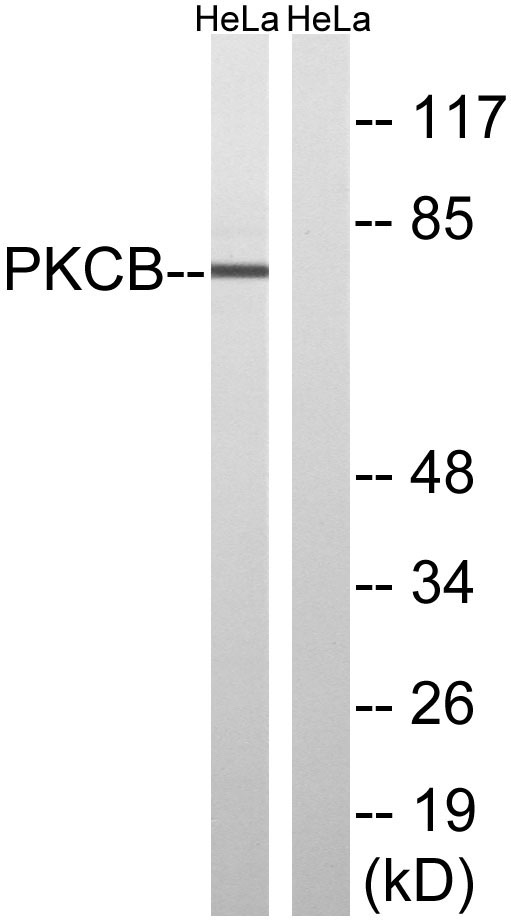PKC β (phospho Ser661) Polyclonal Antibody
- Catalog No.:YP0432
- Applications:WB;IHC;IF;ELISA
- Reactivity:Human;Mouse;Rat
- Target:
- PKC β
- Fields:
- >>EGFR tyrosine kinase inhibitor resistance;>>MAPK signaling pathway;>>ErbB signaling pathway;>>Ras signaling pathway;>>Rap1 signaling pathway;>>Calcium signaling pathway;>>Chemokine signaling pathway;>>NF-kappa B signaling pathway;>>HIF-1 signaling pathway;>>Phosphatidylinositol signaling system;>>Sphingolipid signaling pathway;>>mTOR signaling pathway;>>Vascular smooth muscle contraction;>>Wnt signaling pathway;>>VEGF signaling pathway;>>Focal adhesion;>>Gap junction;>>Neutrophil extracellular trap formation;>>Natural killer cell mediated cytotoxicity;>>B cell receptor signaling pathway;>>Fc gamma R-mediated phagocytosis;>>Leukocyte transendothelial migration;>>Circadian entrainment;>>Long-term potentiation;>>Retrograde endocannabinoid signaling;>>Glutamatergic synapse;>>Cholinergic synapse;>>Serotonergic synapse;>>GABAergic synapse;>>Dopaminergic synapse;>>Long-term depression;>>Inflammatory mediator regulation of TRP channels;>>Insulin secretion;>>GnRH signaling pathway;>>Melanogen
- Gene Name:
- PRKCB
- Protein Name:
- Protein kinase C beta type
- Human Gene Id:
- 5579
- Human Swiss Prot No:
- P05771
- Mouse Gene Id:
- 18751
- Mouse Swiss Prot No:
- P68404
- Rat Gene Id:
- 25023
- Rat Swiss Prot No:
- P68403
- Immunogen:
- The antiserum was produced against synthesized peptide derived from human PKCB around the phosphorylation site of Ser661. AA range:622-671
- Specificity:
- Phospho-PKC β (S661) Polyclonal Antibody detects endogenous levels of PKC β protein only when phosphorylated at S661.
- Formulation:
- Liquid in PBS containing 50% glycerol, 0.5% BSA and 0.02% sodium azide.
- Source:
- Polyclonal, Rabbit,IgG
- Dilution:
- WB 1:500 - 1:2000. IHC 1:100 - 1:300. ELISA: 1:20000.. IF 1:50-200
- Purification:
- The antibody was affinity-purified from rabbit antiserum by affinity-chromatography using epitope-specific immunogen.
- Concentration:
- 1 mg/ml
- Storage Stability:
- -15°C to -25°C/1 year(Do not lower than -25°C)
- Other Name:
- PRKCB;PKCB;PRKCB1;Protein kinase C beta type;PKC-B;PKC-beta
- Observed Band(KD):
- 77kD
- Background:
- Protein kinase C (PKC) is a family of serine- and threonine-specific protein kinases that can be activated by calcium and second messenger diacylglycerol. PKC family members phosphorylate a wide variety of protein targets and are known to be involved in diverse cellular signaling pathways. PKC family members also serve as major receptors for phorbol esters, a class of tumor promoters. Each member of the PKC family has a specific expression profile and is believed to play a distinct role in cells. The protein encoded by this gene is one of the PKC family members. This protein kinase has been reported to be involved in many different cellular functions, such as B cell activation, apoptosis induction, endothelial cell proliferation, and intestinal sugar absorption. Studies in mice also suggest that this kinase may also regulate neuronal functions and correlate fear-induced conflict behavior after stres
- Function:
- catalytic activity:ATP + a protein = ADP + a phosphoprotein.,cofactor:Binds 3 calcium ions per subunit. The ions are bound to the C2 domain.,function:This is a calcium-activated, phospholipid-dependent, serine- and threonine-specific enzyme. PKC is activated by diacylglycerol which in turn phosphorylates a range of cellular proteins. PKC also serves as the receptor for phorbol esters, a class of tumor promoters. May be considered as a novel component of the NF-kappa-B signaling axis responsible for the survival and activation of B-cells after BCR cross-linking.,PTM:Phosphorylation on Thr-500 of isoform beta-I, within the activation loop, renders it competent to autophosphorylate. Subsequent autophosphorylation of Thr-642 maintains catalytic competence, and autophosphorylation on Ser-661 appears to release the kinase into the cytosol. Similarly, isoform beta-II is autophosphorylated on 'T
- Subcellular Location:
- Cytoplasm . Nucleus . Membrane ; Peripheral membrane protein .
- Expression:
- Fetal brain,Hippocampus,Platelet,
- June 19-2018
- WESTERN IMMUNOBLOTTING PROTOCOL
- June 19-2018
- IMMUNOHISTOCHEMISTRY-PARAFFIN PROTOCOL
- June 19-2018
- IMMUNOFLUORESCENCE PROTOCOL
- September 08-2020
- FLOW-CYTOMEYRT-PROTOCOL
- May 20-2022
- Cell-Based ELISA│解您多样本WB检测之困扰
- July 13-2018
- CELL-BASED-ELISA-PROTOCOL-FOR-ACETYL-PROTEIN
- July 13-2018
- CELL-BASED-ELISA-PROTOCOL-FOR-PHOSPHO-PROTEIN
- July 13-2018
- Antibody-FAQs
- Products Images

- Enzyme-Linked Immunosorbent Assay (Phospho-ELISA) for Immunogen Phosphopeptide (Phospho-left) and Non-Phosphopeptide (Phospho-right), using PKCB (Phospho-Ser661) Antibody

- Western blot analysis of lysates from HeLa cells treated with heat shock, using PKCB (Phospho-Ser661) Antibody. The lane on the right is blocked with the phospho peptide.

- Immunohistochemical analysis of paraffin-embedded human tonsil. 1, Antibody was diluted at 1:200(4° overnight). 2, Tris-EDTA,pH9.0 was used for antigen retrieval. 3,Secondary antibody was diluted at 1:200(room temperature, 45min).

